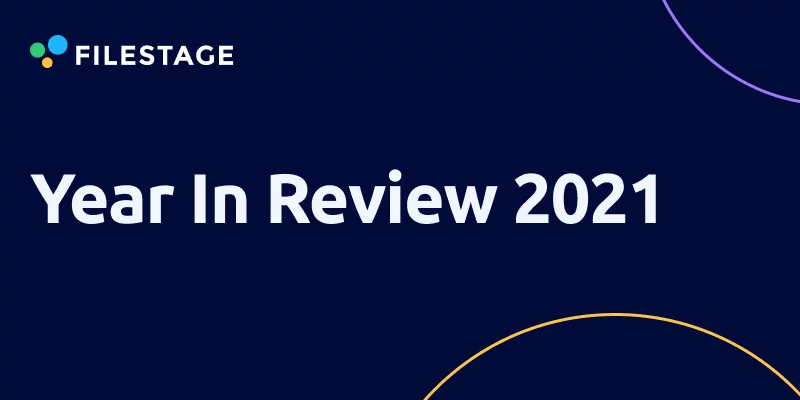The way we collaborate is changing at an astonishing rate, with new problems and opportunities at every turn. In this report, we explore the new home of content creation, the cost of feedback management, and tips to help you create your best work in 2022.
Contents
At the end of 2021, Filestage surveyed hundreds of advertising and marketing professionals. The respondents covered a broad range of experience levels, departments, and company sizes.
But there’s one thing they had in common.
Like millions of others around the world, they create, review, and approve content every month – from TikTok videos to product brochures. This process, we quickly found, is far from perfect.
In this report, you’ll discover how people spent two days per week giving and receiving feedback in 2021. And as we uncover the key problems in the approval process, you’ll learn why 71% of project managers had to arrange meetings to clarify comments.
Let’s begin with the elephant in the room: COVID-19 and the future of work.
Collaboration in the cloud
According to The Economist, only 5% of work in America was done remotely in February 2020. For most of us, the idea of working from home was a pipedream (or nightmare, depending on your perspective).
But the pandemic has changed everything.
9 in 10 worked remotely for at least part of 2021
Over the last 12 months, 40% say that fully remote was their most common work setup. Hybrid working (49%) was the most common setup, but only 11% were in the office full time.
And full-time remote looks set to become the new normal in 2022.
When asked how they’ll collaborate in the coming year, 47% say remotely – up seven percentage points compared to 2021 – and 10% say they’ll collaborate in person. Interestingly, project managers (14%) skew higher while designers and creatives (8%) skew lower.
This presents a new world order for agencies and marketers. The days of gathering around desks, pointing at screens, and chasing elusive reviewers around the building are over. Now, teams need to find smarter ways to share video online and take design feedback into the cloud.
Juniors spent 5x more time in the office than directors
Only 4% of directors worked in the office full time in 2021, compared to 23% of juniors. So why are juniors still braving the commute while their bosses enjoy the comfort and, more importantly, safety of home?
One explanation is that they have less space at home than their senior colleagues, so they prefer to work from the office. Another is that they like grabbing lunch or drinks with colleagues in and around work – and as anyone who’s attended Zoom drinks over the last few years will know, it just isn’t the same from your kitchen table.
And then there’s the cynical argument: trust. It could be that employers simply don’t trust young professionals to put in the hours at home.
Whatever the reason, juniors expect to spend more time in the office than anyone in 2022.
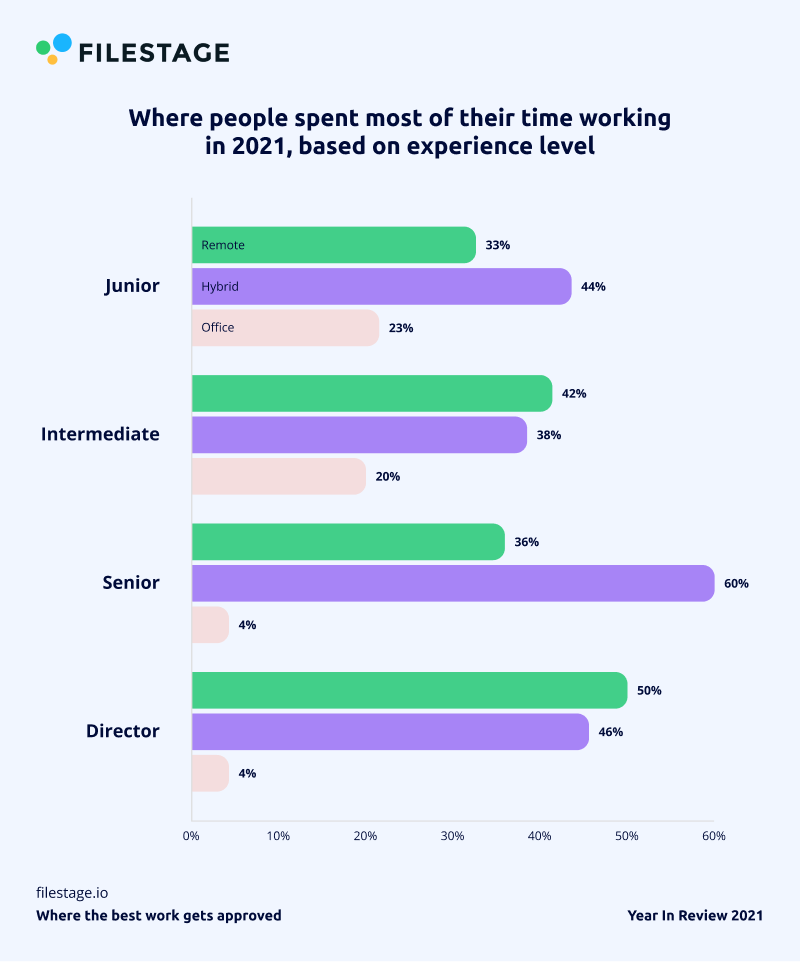
Real time vs. asynchronous – the tipping point
The future of collaboration depends on a battle of work cultures. Whichever comes out of the pandemic on top is likely to stay ahead.
In the blue corner, you have real-time working, where teams gather at desks, in meetings, and on video calls to move projects forward. This is a great way to build strong relationships and bounce ideas around with your teammates. But, often, projects can be held up until everyone has a free slot in their diary.
And in the red corner – the challenger – asynchronous working, which takes advantage of tools like messenger, screen recordings, and online proofing to stop meetings and diaries from getting in the way of progress. This is perfect for people who like to set their own schedules, but teams need to have the right tools in place to see the benefits.
Asynchronous working is in the lead, but only just
52% expect to spend most of their time communicating asynchronously in 2022. The other 48% expect to collaborate in real time.
But that could be enough to tip the scales.
Before the pandemic, working from home was the exception. But in a world where half the team is remote on any given day, important discussions will have to happen in channels rather than corridors. And projects will be drawn up on kanbans instead of whiteboards.
And so, as long as part of the team is set up to work asynchronously, everyone will be.
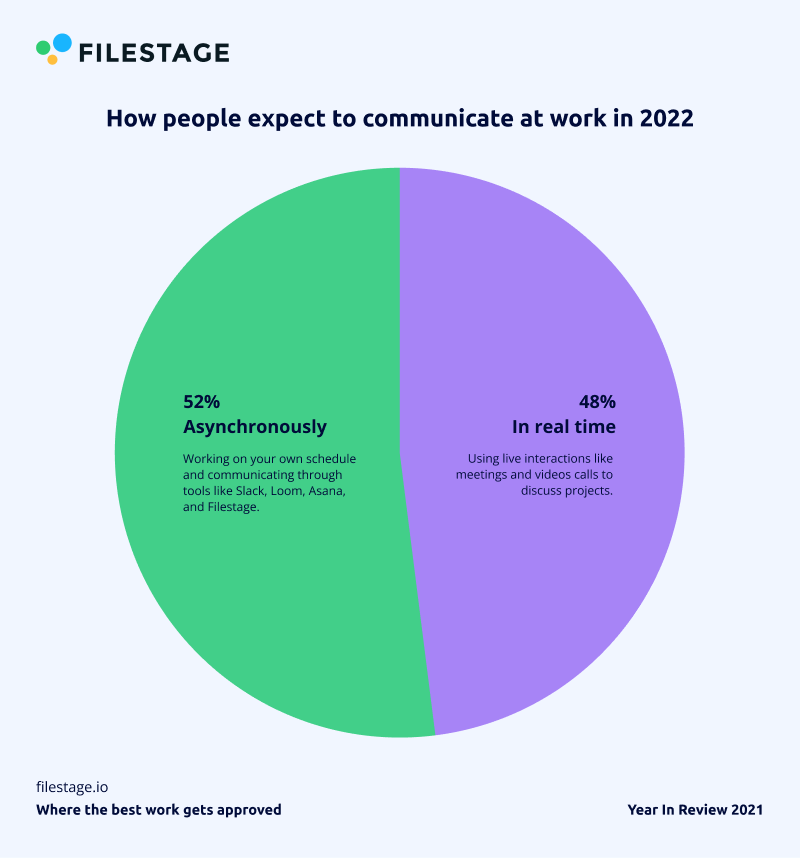
Feedback is getting in the way of great work
Feedback isn’t something we think about every day. We all share work with other people and ask for their thoughts. But rarely do we stop and think about making the process better.
Maybe it’s high time.
Two days per week were spent giving and receiving feedback in 2021
According to our Year In Review survey, people spent just over three hours per day giving and receiving feedback in 2021. That works out at 15.7 hours per week or 68 hours per month.
Here’s a quick breakdown:
- Average time to review a piece of work: 23 minutes
- Average pieces of work reviewed per week: 11
- Average versions reviewed before giving approval: Four
Account managers spent 60% of their time on feedback and approvals
Account managers (1,245 hours), compliance (1,052 hours), and strategists (963 hours) spent the most time giving and receiving feedback in 2021 – closely followed by project managers, who spent 885 hours.
And when comparing the differences across experience levels, we found that seniors (909 hours) spent the most time on feedback per month, while juniors (499 hours) spent the least.
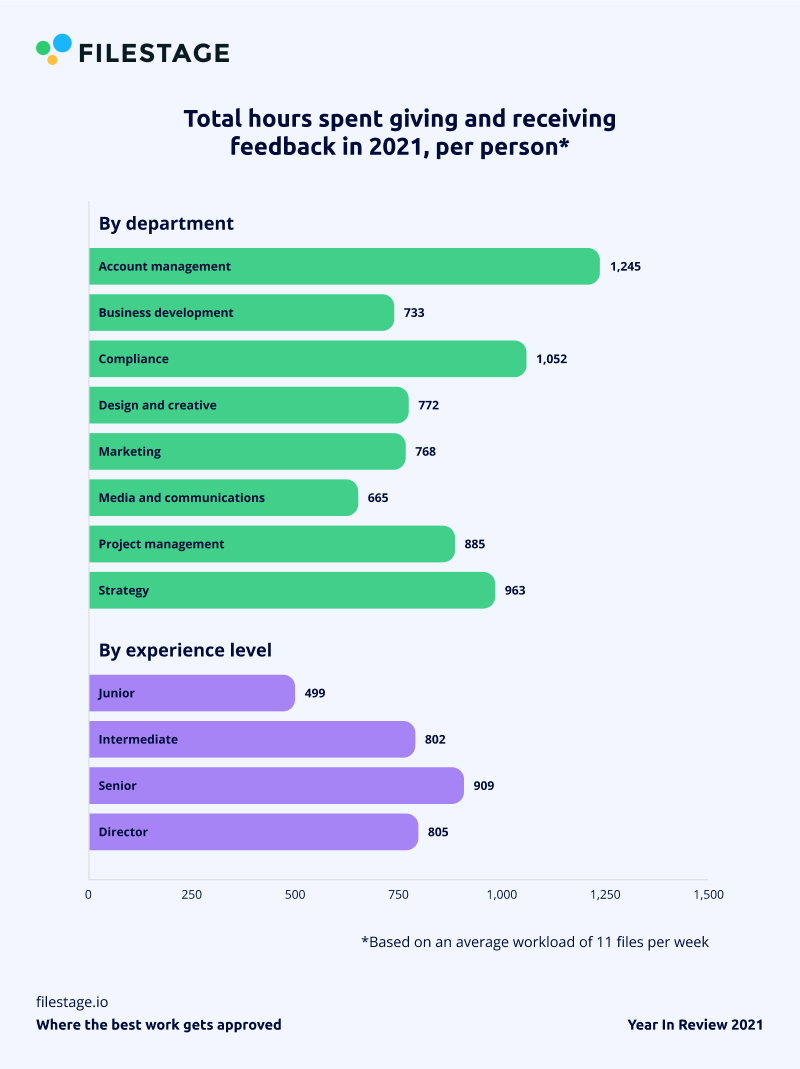
89% say they’d feel happier at work if their team had a more efficient review and approval process
Despite spending more time at home in 2021, people are feeling the pressure more than ever – especially when it comes to getting work across the finish line.
Here’s how things changed in the last year:
- 68% say their workload increased
- 60% say their deadlines became more demanding
- 1 in 3 say regulations and compliance became a bigger issue
With more work to deliver, more people to review it, and more challenging deadlines to meet, it’s no surprise that 2 in 3 people feel stressed or frustrated because of their review and approval process.
Could this be another factor feeding into the Great Resignation?
When you’re working from home, the differences between one job and the next are slim. So as workloads pile up and stress levels rise, companies have to ask themselves: how can we make life easier for our employees?
According to 89% of our respondents, a more efficient review and approval process would be a great start.
3 in 4 say they could create better work if they spent less time managing feedback
In the last few decades, businesses have invested billions of dollars in digital transformation. And each tool or advancement has brought new benefits:
- Cloud drives let you access files anywhere in the world
- Messenger apps make communication faster and clearer
- Project management tools keep your team aligned and focused
And if the goal of all this is to get more done in less time, companies would be wise to work on their review and approval process in 2022.
By improving efficiency, communication, and consistency throughout the review and approval process, teams will save time and money while empowering people to deliver their best work.
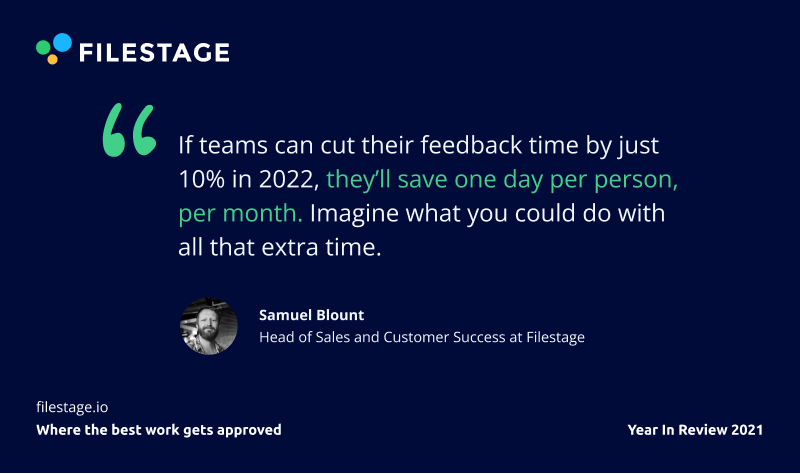
The need for speed (and clarity)
When asked to rate its efficiency, 83% said their team’s review and approval process was efficient or very efficient. But when you scratch beneath the surface, there are two major problems that are worth a closer look.
The first is time.
1 in 2 say delayed feedback from reviewers slowed them down in 2021
When asked which issues contributed to their team’s inefficiency over the last 12 months, 49% say delayed feedback from reviewers. For project managers and account managers, that rises to 62% and 80% respectively.
And the problems don’t stop there.
48% had to chase people for approval in an effort to move projects forward. And 38% were forced to move deadlines to allow more time for feedback.
14% of marketers canceled projects in the last year because files weren’t approved in time
For some, chasing reviewers and shifting deadlines wasn’t enough to get work across the finish line.
In 2021, 8% say they canceled projects because the work wasn’t approved in time. For marketers (14%), strategists (13%), and media specialists (13%), the figures are even higher.
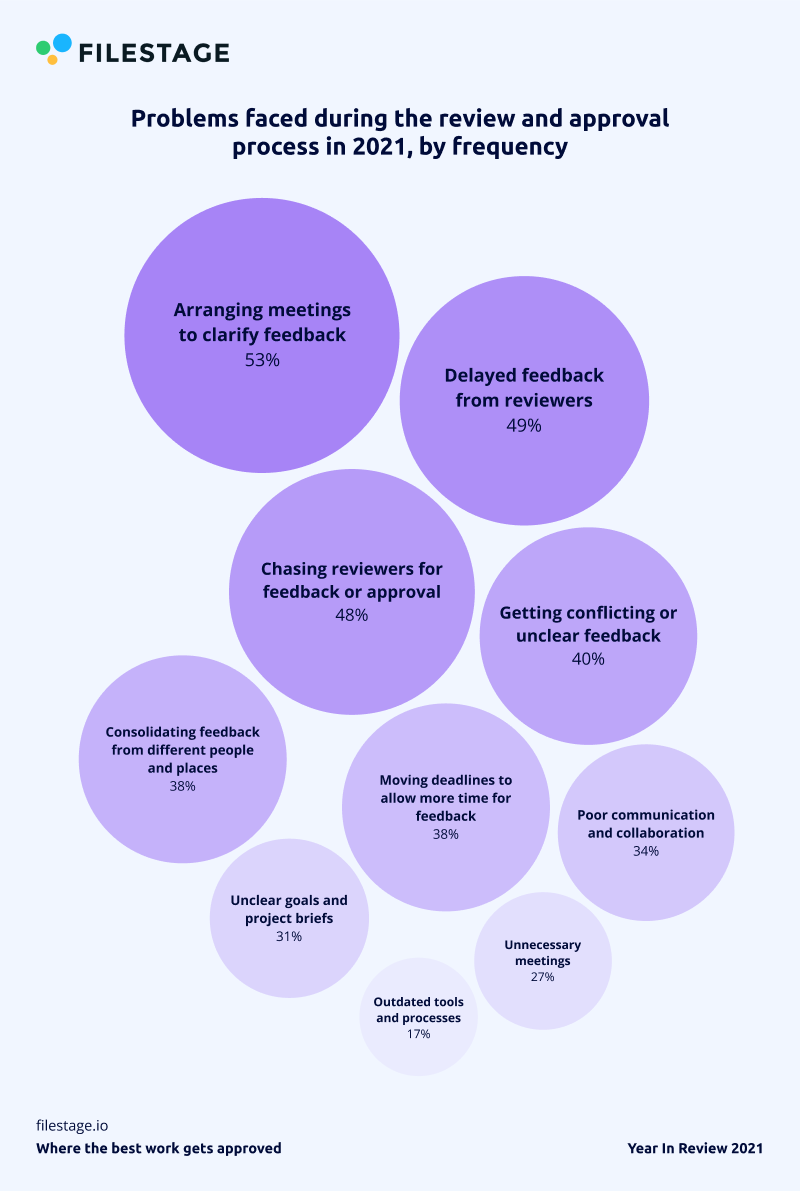
1 in 3 say communication and collaboration isn’t good enough
When it comes to marketing, agencies and in-house teams are communication experts. But the same can’t be said for internal comms: 34% say their team suffers from poor communication and collaboration.
Brands and agencies rarely have a clear process when it comes to sharing files and collecting feedback. So it’s no surprise that 53% of marketers had to consolidate feedback from different people and places in 2021.
This could come from any number of channels:
- Video calls
- In-app comments
- Handwritten notes
And the result? 40% received conflicting or unclear feedback on their work in the last year. For strategists, that rises to 63%.
71% of project managers have arranged meetings to clarify feedback
If everyone has their own way of giving feedback, there’s a very high chance that reviewers aren’t discussing (or even seeing) each other’s comments.
So what do you do when one person says “make it red” in an email, while another says “make it blue” in your presentation’s comments? According to the data, you call a meeting.
In 2021, 53% arranged meetings to clarify feedback from reviewers and get everyone aligned. Account managers (80%), project managers (71%), and marketers (64%) experienced this problem more than anyone.

Taking control of the approval process
Ever struggled to find the latest version of a file? You’re not alone. In the last 12 months, 3 in 10 say they didn’t know where to find a piece of work. And 31% say their files and folders are disorganized, leading to inefficiencies across the team.
But that’s just the tip of the iceberg.
Teams don’t have a clear process for getting work approved
When reviewing a piece of work, 14% say they don’t know the best method for sharing feedback.
So what do they do? They make their own choices. Email, in-app comments, or maybe just a quick one-to-one video call. No wonder 18% say they lost track of who had approved a piece of work at least once in the last year. For account managers (40%) and compliance (33%), the figures were even higher.
14% of marketers have published mistakes because important review steps were missed
Then there are those who put off giving feedback altogether. 21% say they received feedback on an old version of a file in the last year, giving reviewers no choice but to review it again – this time with the latest version.
This can easily lead to delays and frustration. And because teams are already struggling to track who’s approved what, mistakes are slipping through the net.
In 2021, around 1 in 10 people published mistakes because important review steps were missed. Designers and creatives (13%) and marketers (14%) faced this problem the most.
And for anyone concerned about regulations, compliance, or brand image, mistakes aren’t an option.
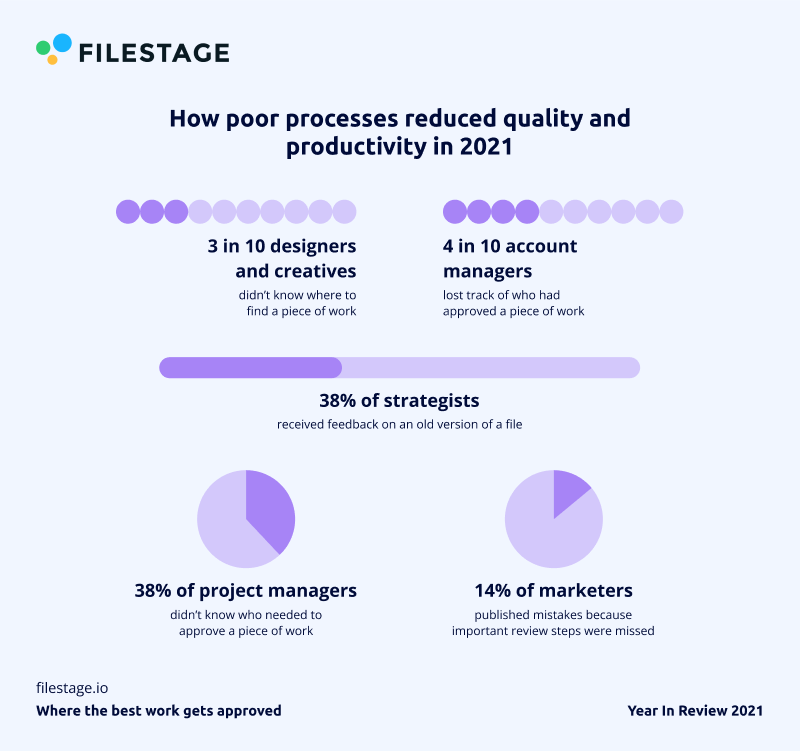
Brands and agencies with a dedicated tool saved 62 hours per person in 2021
In our Year In Review survey, we asked people how they shared work and collected feedback. We then looked at the average time they spent reviewing each piece of work.
By combining this with the average number of files (46) and versions (4) reviewed per month, we can see how long people spend managing feedback based on their review process.
Here are the results, from fastest to slowest:
- Filestage – 66.9 hours per month
- Video call – 71.6 hours per month
- In-app comments – 72.3 hours per month
- Email – 74.1 hours per month
- Annotated printouts – 75.3 hours per month
Switching from email to Filestage could save your team around one day per person, per month
For one reason or another, millions of people still use email to get feedback on their work. This is especially true for teams working with external partners or sharing work with clients.
But by switching from email to Filestage, each person in your review process could save 7.2 hours per month – or 86 hours across the year.
Here’s how that could look on a company level:
- A team of 15 people review 25 pieces of work per week, and it usually takes four versions to get approval.
- With email, they can expect to spend 2,631 hours per month giving and receiving feedback.
- With Filestage, they can review the same amount of work in 2,376 hours – a saving of 255 hours per month.
- Based on an hourly salary of $50, that’s a saving of $12,737.66 per month.
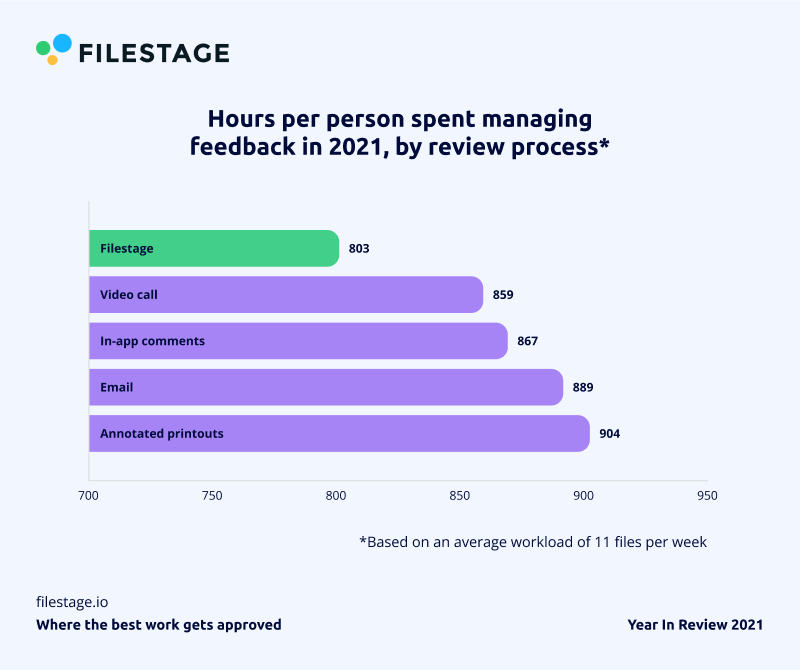
Methodology
Filestage surveyed 263 people across a range of countries, industries, and departments. The data was then collected and cross-referenced to create the Year In Review 2021.
We pledged to plant one tree for each person that responded to the survey, but chose to go a step further by planting 500 trees with Ecologi.
Fair use statement
If you’d like to share these findings with your audience, we kindly ask that you credit our research with a link back to this page. This will allow your readers to explore the data in its entirety.

